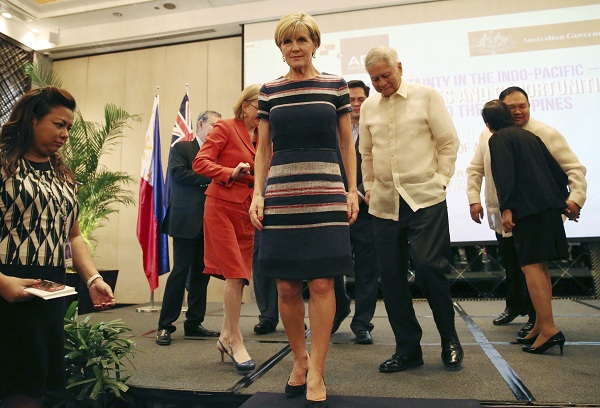
An Australian think tank said that the likelihood of an Islamic State of Iraq and Syria (ISIS) caliphate in Mindanao is low after Australian Foreign Minister Julie Bishop expressed concern over this possibility over the weekend. The think tank said extremism is the more serious issue facing the governments in the region. AP/Aaron Favila
An Australian think tank on Wednesday said that the likelihood of a so-called Islamic State of Iraq and Syria “caliphate” emerging in Mindanao is low, and the greater danger coming out of the troubled Philippine south is the threat of pro-ISIS extremists.
Sidney Jones of the Lowy Institute for International Policy said in an article that even if the threat of a caliphate in Mindanao is low, the governments in Southeast Asia should rightfully focus their attention on the southern Philippine island because extremist groups could use it as base from which to plan attacks on Manila and other cities or train fighters who will carry out these activities.
“Even if the likelihood of a 'caliphate' emerging on Australia's doorstep is low, Australian Foreign Minister Julie Bishop is right to focus attention on the southern Philippines,” Jones said.
She added: “The more likely danger is that pro-Islamic State extremists with deadly skills may use bases there to plan hits in Mindanao and Manila, or train operatives to carry out attacks elsewhere in the region. It is unlikely that hundreds of foreign fighters will flee there as Islamic State is pushed back, but even a dozen could cause serious damage.”
Over the weekend, Australian Foreign Minister Julie Bishop expressed Canberra’s concern that ISIS might establish a caliphate in Mindanao as the group, which is also referred to as IS for Islamic State, is already being pushed out of the Middle East.
Jones said that fighters from Indonesia and Malaysia and even from countries farther away have been working with extremists in mainland Mindanao and Basilan since 2014. She added that several of these groups formed an alliance in early 2016 with the blessing of ISIS and swore loyalty to Isnilon Hapilon, the Basilan-based leader of Abu Sayyaf.
Their plans to establish a Southeast Asian province (wilayat) of ISIS based in Basilan never materialized however for still unknown reasons.
“Southeast Asian IS leaders in Syria have been urging their followers at home to join the jihad in the Philippines, and local leaders have been recruiting as well,” she said.
Although their number is small, they are still dangerous because, according to Jones, they are educated men with good funding networks.
Here are five reasons the Philippines and the region should be concerned about these extremists:
The alliance of pro-IS groups in the Philippines has crossed clan and ethnic lines which before have hampered unity. This has brought together Hapilon’s Yakan from Basilan, Maute brothers’ Maranao fighters from Lanao De Sur, Central Mindanao’s Bangsamoro Islamic Freedom Fighters, Zamboanga’s Abu Sayyaf Urban Terrorist Group and Rajah Sulaiman Movement members from Luzon and Visayas who have converted to Islam. These groups have carried out attacks in the past, such as the Davao night market bombing last September.
This alliance has a steady supply of money apparently arranged in part through Mahmud Ahmad (also known as Abu Handzalah), a Malaysian professor who joined Hapilon in September 2014. This money has kept Hapilon’s group from kidnapping-for-ransom activities, which are the work of other factions of the Abu Sayyaf not linked to IS. If this supply of money is stanched, Hapilon’s group could return to their former methods.
Malaysian and Indonesian supporters are trying to recruit people to join ISIS. The Philippine government’s intensified campaign against the Abu Sayyaf has killed many fighters and injured Hapilon himself. Three men and a woman who were reportedly trying to recruit Bangladeshi workers and ethnic Rohingya were arrested by Malaysian police in Sabah . This connection with Bangladeshi extremists is the last thing governments in the region needs.
The alliance could provide ISIS fighters from the region and even the Middle East safe haven owing to the extremely porous borders among Malaysia, Indonesia and the Philippines. Australian ISIS supporter Musa Cerantonio was deported by the Philippines in 2014. Terrorists from Indonesia have a history of fleeing to Mindanao, and several Bali bombers ended up on the island. In recent weeks, the Singaporean Mohammad Ali bin Abdulrahman has been the target of air strikes in Maguindanao.
The problem is spreading from Mindanao to other countries in the region. Indonesian police have recently arrested a pro-ISIS group in Banten whose leader has made several trips to Mindanao to buy guns from Hapilon’s group.
Jones however said that it was unlikely that a flood of returnees would fly back to the region because many of them left with no intention of returning or have already married locally.
She said that the Australian government should continue its assistance program to Mindanao to increase the capacity for governance of local governments on the island and remove areas where these extremists could operate.
The peace process is also integral in weeding out the extremist threat as well as enhanced cooperation and training among Australian, Indonesian, Malaysian and Philippine police.
“The biggest mistakes the Australian government could make would be prioritizing counter-terrorism over all else or assuming that [Philippine President Rodrigo] Duterte's military operations will end the problem,” she said.
http://www.philstar.com/headlines/2017/03/29/1685728/five-reasons-we-should-worry-about-extremism-mindanao

No comments:
Post a Comment
Note: Only a member of this blog may post a comment.